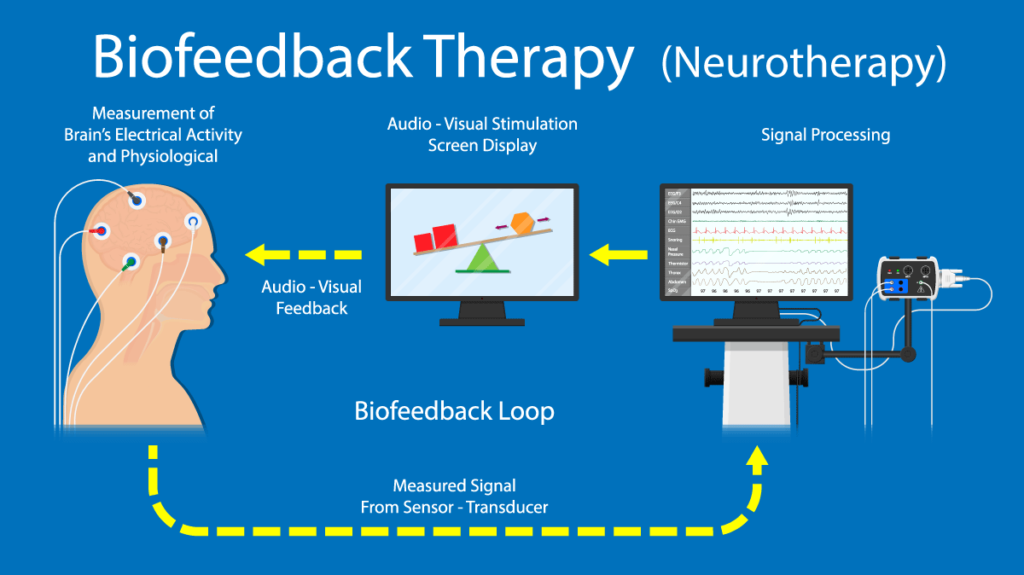If you are like me you are new to Neurotherapy, but if you're a curious life-long learner, keep reading!
Do you ever feel overwhelmed by your thoughts and emotions? If so, Neurotherapy may be something interesting to explore. I am curious about all strategies and practices for one to live their best life. Neurotherapy although new to me looks pretty intriguing.
Neurotherapy is a type of therapy that helps people regulate their thoughts and emotions.
It can be an effective treatment for conditions like anxiety, ADHD, and depression. If ya know my back story, you know I’ve dealt with a deep dark depression a decade ago.
In this blog post, I will explore what Neurotherapy is and how it can help you live a happier, healthier life.
Let’s get into it. You ready?
What Is Neurotherapy?

In my research of this topic I found this video that helped me wrap my head around this topic of Neurotherapy. Have a watch and enjoy learning if you’re new to this topic. It’s very cool and the brain training looks pretty powerful. I also found this article on the Brain Therapy Center website.
In neuroscience, there exists an experimental field called Neurotherapy.
It is synonymous with neurofeedback and is a specific form of what is called “biofeedback” – that is, training one’s self, based on recordings of the exact and unique way your own individual body functions.
Neurofeedback is generally done by strapping monitoring equipment to the patient’s head and giving them live feedback on a screen so they can attune themselves and reinforce the desired behavior or state.
Usually, they are done via the use of QEEG (Quantitative Electroencephalography) or FMRI (Functional Magnetic Resonance Imaging).
It is important to understand that this is not surgical or intrusive in any way, purely done on the level of the skin with no needles or anything like that.
This training of the mind helps to be more aware of itself and is also known as a form of operant conditioning.
The simplest way to explain it is with Ivan Pavlov’s iconic dog experiment, where he would regularly ring a bell before feeding his dog, after which the dog would naturally learn to expect food when he heard the noise.
It is also similar to a very popular type of therapy – CBT, Cognitive-Behavior Therapy.
What are The Benefits Of Neurotherapy

Cognitive Function

Neurotherapy has been shown to help people with problems in certain areas, and better improve their calm and focus.
Through repetition and inducing a sense of confidence in the subject, this technique can have limited application in inducing music, athletic, and creative ability
Improved Attention

One of the main selling points of Neurotherapy is its benefits to people suffering from ADHD – Attention Deficit Hyperactive Disorder.
Studies have shown significant evidence for help in decreasing all aspects of ADHD in patients, however, only helping boost the effectiveness of conventional treatment, not as a substitute for it.
This is an area I find intriguing as my son has ADHD and after seeing some of the symptoms, I’d be if I was tested I’d also have at least mild ADHD. The thought of using brain training strategies like this instead of medication seems like a great strategy, but as mentioned above it seems it may not be a replacement to conventional treatments. I will be researching deeper though.
Anxiety & Stress Management

How Long Does it Take for Neurotherapy to Work?

This is a tough question to answer at least in my research. I have not found a definitive source and it seems people are all over the place on how quickly these session might really get results or make progress.
So for example MyBrainDR.com said… “Most people find the neurofeedback process and training relaxing – some feel relief and results immediately, but every patient is different. Most of our patients begin to feel the benefits of neurofeedback in 3-4 weeks, or 6-8 sessions.”
Then NOVAneurotherapy.com said… “This simple question has a simple answer that needs much elaboration–it is different for each person, and I find it quite difficult to predict who will begin to respond within a few sessions and who will take considerably longer. The usual person needs 40-60 sessions of neurofeedback to make meaningful and lasting changes. However, there are factors that might be under the control of person receiving neurofeedback that can augment or counter the effectiveness of neurofeedback.”
So you can see with my limited expertise and maybe since this is a newer practice or maybe just every situation is different, we have no hard data or perfect and exact timeframe that I can say without a doubt this should be your experience with this therapy.
Obviously 40-60 sessions might be a big investment of time unless you have a dire situation you are trying to fix, like the examples of the guys learning to control a prosthetic arm/arm or move the wheelchair with your brain. For those like me a bit curious at if this would help to improve focus or brain training we may not want to commit to needing 60 sessions.
Is Neurotherapy Safe?

The Drake Institute of Neurophysical Medicine had this to say on the saftey of neurotherapy or neurofeedback… “Neurofeedback is safe and effective for treating the above-mentioned disorders and their accompanying physiological and neurological symptoms. What’s more, it’s safe for both children and adults.
At the Drake Institute, every neurofeedback treatment protocol is tailor-made by our medical director to achieve the best results for each patient.
These protocols do not include external stimulation or medications. Instead, neurofeedback is simply a means of measuring and displaying a patient’s brainwave activity so the patient can make healthy desired changes.”
Who Is Neurotherapy For?
At the end of the day, neuroptherapy is still a relatively young field, with it being theoretically
around 40 years, with real, practical research coming in the back half.
While there are tremendous theoretical benefits if we can definitively prove its validity, it shouldn’t be anyone’s first response to a possible mental disorder or perceived lack of focus
and artistic ability.
That said, the great value of this approach is that there are practically no negative side effects whatsoever.
Meaning that should you find yourself with the time and money to be able to afford it, it can be a positive experience.
Who knows? You might even contribute to some groundbreaking research!
With all my experience with meditation and mindfulness as well as researching, learning, and testing a bit of psychology in my own world, I know the power of the brain is immense. In typical Western society, we overlook a lot of very powerful brain programming practices and who knows… maybe Neurotherapy is another one we are overlooking that could truly benefit us and our health.
What do you think? Have you heard of Neurotherapy? Have you tried it? If so share your experience. If this is new to you does it seem like an exciting field or some sort of quackery? Share your thoughts in the blog comments below.
Other Neurotherapy Resources…
- International Society of Neuroregulation & Research (ISNR)
- Association for Applied Psychophysiology & Biofeedback (AAPB)
- Combined Neurofeedback and Heart Rate Variability Training for Individuals with Symptoms of Anxiety and Depression: A Retrospective StudA randomized controlled study of neurofeedback for chronic PTSD
Want to try adding mindfulness and meditation to your self-care routine? Click below to get details about the Introduction to Mindfulness & Meditation mini-course.

